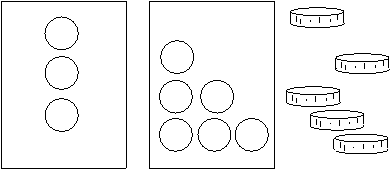renewal cycles. Complete
some now & some later.
and Get 25% off
the Total price!
Buy 3 Courses
and Get 30% off
the Total price!
Buy 4 Courses
and Get 35% off
the Total price!
| Create Account | Login | ||

Section 28
Bag Labels & Inservice Training Sheets
Table of Contents | NCCAP/NCTRC CE Booklet
In-service Training Sheets
Reproducible Masters
Alzheimer’s & Low Functioning Activities
with QI Based Care Plans

In order to encourage your entire facility staff to use Success Therapy® Projects, place the project in a paper or plastic bag. If using paper bags, cuff the top and tape the bag to the resident’s night stand, or other visible location. Write the resident’s name on the front of the bag. Duplicate the Training Sheets, cut each in half, so one project appears per Sheet. Write specific directions for using the Success Therapy® activity with a particular resident on the label found at the front of this Manual. For example, “speak slowly, place cap in hand to get started” and so on.
Regularly replace bag, project, and In-service Training sheet as needed.
State Regulations and State Surveyors vary concerning their individual interpretation regarding the Resident’s Right to dignity and privacy. Therefore, the placement of these In-service Training Sheets may vary depending upon your State’s interpretation in these areas. However, the ideal location for these Training Sheets, to convey the training information to the entire staff, is in the Success Therapy® bag taped to the night stand or other visible easily accessible location to be used with the resident.
Success Therapy® In-service
Training Sheet
for_____________________________________
Resident’s Name

Can Rolling
The object of Can Rolling is to do exactly that, to roll the can, as a hand exercise.
To prevent the can from merely sliding across the surface rather than rolling, place a towel on the surface first.
Place the resident’s hand on top of the container. Gently help him or her roll the can back and fort.
Notice the angle of your resident’s shoulder, elbow, and wrist to make sure they are at the best angle for the easiest rolling. Note on the reverse side of this sheet, if any type of rolled-towel-support might assist your resident’s success with this activity.
Once you get started with Can Rolling, help him or her to apply even pressure and avoid grabbing the can and a scrubbing motion.
Remember Success is your primary purpose. What you are really doing is providing a task to allow you an opportunity to say something like, “Good, great, you did a good job! Would you like to try again?” Thus, you are providing this resident with a situation in which he or she can experience a feeling of accomplishment, self-worth, and SUCCESS!
SHARE YOUR SUCCESS! Staff, Volunteers, Family, and Visitors please feel free to use the reverse side of this sheet to note any successful experiences you have with this resident.
Success Therapy® In-service
Training Sheet
for_____________________________________
Resident’s Name

Bank Exercise
The object of the Bank Exercise is for the resident to drop the cap through the slot in the lid. Thus, the name the Bank Exercise, as it is similar to dropping coins into a bank.
A basic goal for your resident to accomplish would be to drop 2 or 3 caps into the Bank with total physical assistance. To accomplish this, you would place the cap between your resident’s thumb and index finger, place their hand over the lid of the bowl and actually you push the cap through the lid. You might then say, “Good! Great job, you really did a good job!” Then place another cap between their thumb and index finger and repeat. Keep in mind this provides the resident with an opportunity to have a successful experience and a feeling of accomplishment.
A higher level of difficulty would be to place the cap in the Bank with partial physical assistance. Place the cap in your resident’s hand. With some physical assistance, the resident pushes the cap through the hole. An approach to help your resident accomplish this task might be, “to use the resident’s name” or “to request the resident to drop the cap into the Bank.”
The highest level of difficulty... is when the resident places the cap in the Bank upon your request. You would say for example, “Mary, can you put the cap in the Bank for me?” Mary picks up the cap and drops or pushes it through the hole, depending on the size of hole cut. The difference between this and the previous approach is that only verbal prompting is used with no physical assistance.
SHARE YOUR SUCCESS! Staff, Volunteers, Family, and Visitors please feel free to use the reverse side of this sheet to note any successful experiences you have with the resident.
Success Therapy® In-service
Training Sheet
for_____________________________________
Resident’s Name

Caps-in-a-Bowl
The object of Caps-in-a-Bowl is for the resident to drop the cap into the bowl. Thus, the name of the activity is Caps-in-a-Bowl.
Start off by saying something like, “I’ve got a hand exercise (or a game) for you to try. Would you like to try a hand exercise (or a game) for me?” Note response. Then say, “Let’s see if you can drop this cap in the bowl? Would you like to do that?” If the resident has little capability, place the cap between the resident’s thumb and index finger and gently pull their finger out, if they are unable to do so themselves. Thus the cap drops into the bowl.
If your resident has a little more ability perhaps he or she is able to hold the cap independently. Your goal might then be “to drop the cap into the bowl upon request.” Thus, you might say to the resident, “(their name) let’s see if you can do this for me.” You demonstrate dropping 2 or 3 caps into the bowl slowly, one at a time, limiting your speech, because it may be distracting.
If your resident has a little more ability the next level of difficulty would be “to drop the cap in the bowl independently once started.” That means you would demonstrate how to drop the cap into the bowl. Your resident then would continue to pick-up caps and drop them into the bowl independently.
Remember Success is your primary purpose. What you are really doing is providing a task to allow you an opportunity to say something like, “Good, great, you did a good job! Would you like to try again?” Thus, you are providing the resident with a situation in which he or she can experience a feeling of accomplishment, self-worth, and SUCCESS!
Success Therapy® In-service
Training Sheet
for_____________________________________
Resident’s Name

Color Pattern Cards
The object of Color Pattern Cards is to place the cap on the dot, either matching or not matching the color, depending upon your resident’s ability level.
The way to introduce this Success Therapy® activity to the resident is to say something like, “I’ve got a game for you to play today. Would you like to play a game?” Always be aware of the resident’s understanding and seeming willingness to go along with the activity. As you know, this can change from day-to-day or even minute-to-minute. If he or she seems receptive, offer a cap.
After a few demonstrations say, “Take the cap and put it on the dot.” Initially, do not request that s/he place the cap on the corresponding color, if the resident seems to get the idea. Place a second cap in their hand and make the same request.
Depending upon the resident’s ability, you would place the Color Pattern Card in front of your resident and severalcaps. The resident would next place the caps on the dots independently.
Sample approaches to use would be “to demonstrate the activity;” “to encourage with praise;” or “to remind your resident that he or she is helping to keep their finger from getting stiff.”
SHARE YOUR SUCCESS! Staff, Volunteers, Family, and Visitors please feel free to use the reverse side of this sheet to note any successful experiences you have with the resident.
Success Therapy® In-service
Training Sheet
for_____________________________________
Resident’s Name

Color Sorting
The object of Color Sorting is for the resident to sort the caps into the correct bowl that matches their color.
Initiate this activity with your resident by demonstrating first and then offering him or her a cap. Ask your resident to put the red cap, for example, in the red bowl, or whatever color you have available.
To assist your resident you might use an elbow prompt. By this I mean you would ask, “Can you put the red cap in the red bowl like I did?” Place the red cap in your resident’s hand. You might then nudge their elbow gently towards the correct bowl. Note, of course, if this physical prompting is needed and acceptable to your resident.
A way to increase the difficulty of Color Sorting is by decreasing the level of the instruction you give. A sample goal might be “to do Color Sorting after four demonstrations” or “to do Color Sorting after one demonstration.”
Remember Success is your primary purpose. What you are really doing is providing a task to allow you an opportunity to say something like, “Good, great, you did a good job! Would you like to try again?” Thus, you are providing the resident with a situation in which he or she can experience a feeling of accomplishment, self-worth, and SUCCESS!
Success Therapy® In-service
Training Sheet
for_____________________________________
Resident’s Name

Shape Sorting Box
The object of the Shape Sorting Box is to drop the shape through the correct hole. To start, put the Shape Sorting Box in front of your resident and say for example, “Martha, I have a game for you to play, would you like to play a game today?” Note the resident’s response. Then say, “Let me show you how this works.” Take an object and show the resident how it drops through the hole. Demonstrate a couple of times.
Then hand one object to your resident with no or little verbal direction to see if s/he understood how to push the object through the hole. If your resident starts to put it through the wrong hole, gently guide their hand over to the correct hole. Then provide assistance, if needed, to drop the object through the hole.
Other approaches to motivate your resident might be “to encourage with praise” or “to encourage with the fun aspect of a game or puzzle” or “to remind your resident that picking up and pushing the pieces through the holes is a good finger exercise.” You be the judge as to what motivates him or her the best.
Remember Success is your primary purpose. What you are really doing is providing a task to allow you an opportunity to say something like, “Good, great, you did a good job! Would you like to try again?” Thus, you are providing the resident with a situation in which he or she can experience a feeling of accomplishment, self-worth, and SUCCESS!
SHARE YOUR SUCCESS! Staff, Volunteers, Family, and Visitors please feel free to use the reverse side of this sheet to note any successful experiences you have with the resident.
Success Therapy® In-service
Training Sheet
for_____________________________________
Resident’s Name

Geometric Puzzle
The object of this Geometric Puzzle is for the resident to place the corresponding puzzle piece over the shape on the card.
An example of a way to motivate your resident to do the Geometric Puzzle is to start by saying something like, “I have a game for you. Do you want to play a game today?” Then demonstrate the activity. Place the puzzle piece on the card over the shape that it matches.
The next step is to place the puzzle piece in your resident’s hand and observe if s/he can place it on the card. Of course, if your resident can pick up the piece independently, encourage him or her to do so.
SHARE YOUR SUCCESS! Staff, Volunteers, Family, and Visitors please feel free to use the reverse side of this sheet to note any successful experiences you have with the resident.


